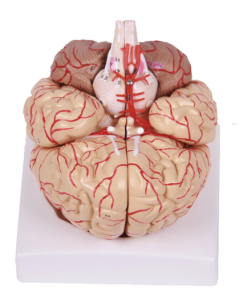Homepageпјҡ NEWS >> The Cerebral Artery Journey: A detailed explanation of the brain attached to the cerebral artery model
When we talk about the mysteries of the brain, cerebral arteries play a vital role as the main passageway of blood supply to the brain. In order to better understand the structure and function of cerebral artery, brain-attached cerebral artery model has become an important tool in medical teaching and research. Below, we will analyze this model in detail and take you on a "journey of brain arteries".

I. Overview of the model
The cerebral appendicular artery model is a highly simulated anatomical model of the brain, which accurately shows the structure and distribution of the arteries inside the brain. The model consists of several components, including the base of the skull, the cerebral hemisphere, the cerebellum, the brainstem, etc., and the vascular connections between them. The vascular network on the model is clearly visible, and the branch, course and intersection of cerebral arteries can be visually observed.
Ii. Structure of cerebral artery system
In the model, we can see that the cerebral artery system is mainly composed of two major systems, the internal carotid artery and the vertebral artery. The internal carotid artery enters the cranial cavity through the carotid foramen of the temporal bone and provides blood supply to the front 2/3 of the cerebral hemisphere and part of the diencephalon. The vertebral artery supplies the posterior 1/3 of the cerebral hemisphere and part of the diencephalon, brainstem, and cerebellum.
Specifically, the internal carotid artery, after entering the skull cavity, will form a U-shaped structure, which is a good place for atherosclerosis. Then, the internal carotid artery divides into important branches such as the middle cerebral artery and the anterior cerebral artery to supply blood to different areas of the brain. The middle cerebral artery is responsible for supplying most of the outer hemisphere of the brain, and once blocked, it can seriously affect the body's sense of movement. The anterior cerebral artery supplies blood to the medial side of the brain before the parieto-occipital sulci.
The vertebral arteries converge near the medulla oblongata and pons to form the basilar arteries, which branch off the posterior cerebral arteries, etc., to supply blood to the posterior regions of the brain. The posterior cerebral artery runs backward along the lower part of the brain, eventually supplying the occipital lobe, the medial side of the temporal lobe, and the basal side of the brain.
Third, the teaching and research value of the model
The brain-attached cerebral artery model is not only highly realistic and intuitive, but also interactive, allowing students and researchers to deepen their understanding of the structure and function of cerebral arteries through practical operation. In medical education, this model can help students better grasp the knowledge of brain anatomy and improve the teaching effect. In the field of scientific research, the model can provide researchers with intuitive reference of brain anatomy structure and promote the in-depth scientific research work.
In conclusion, the brain-attached cerebral artery model is an important tool for medical teaching and research, which provides us with an intuitive and vivid display platform of the cerebral artery system and helps us to better understand and explore the mysteries of the brain.